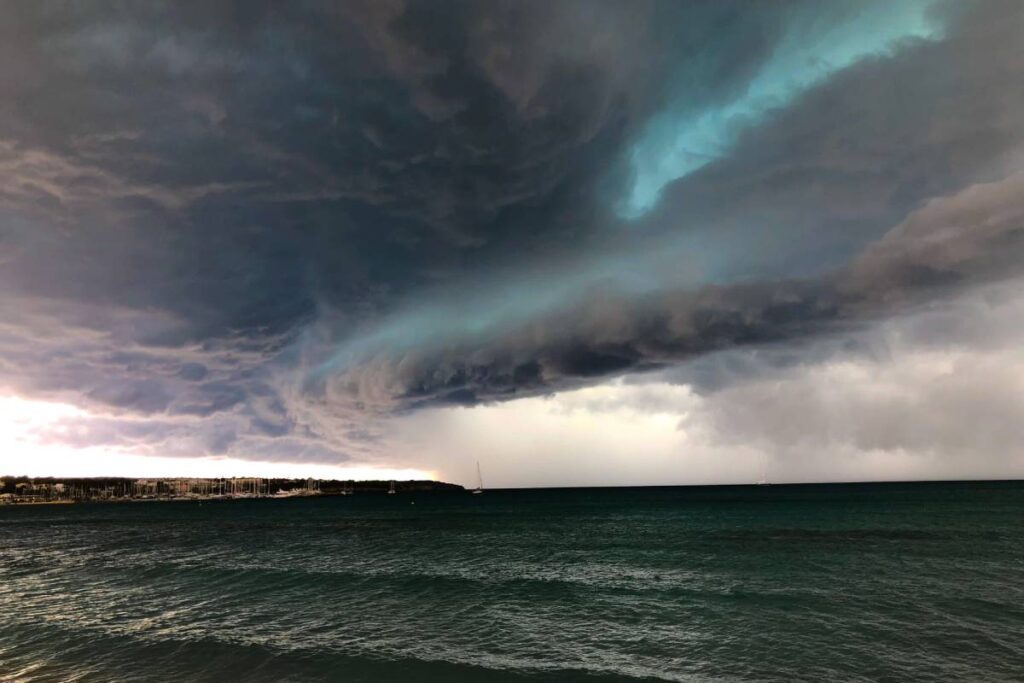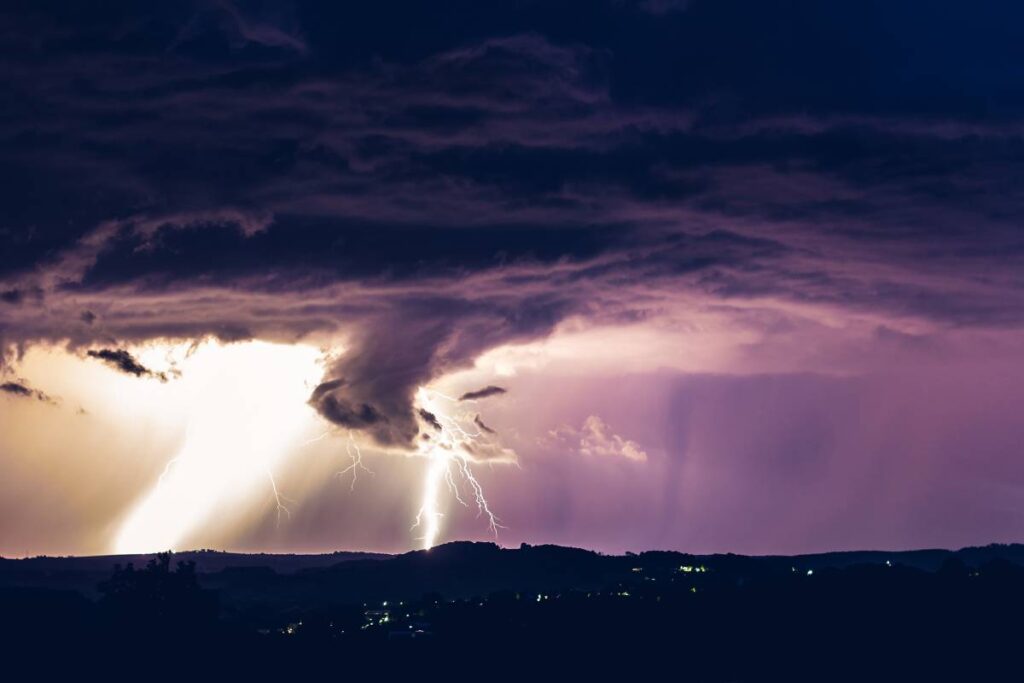Wind swirling, or the circular motion of air, is a fascinating natural phenomenon often seen in tornadoes, hurricanes, and even simple gusts that can easily rip off your metal roof. The primary causes of swirling wind involve several key factors: pressure differences, the Earth’s rotation, and geographical influences.
In this article, we’ll look into the causes of why storms like tornados or hurricanes are usually spinning when they emerge. What causes them to swirl, let’s get into it.
Pressure Differences
The most fundamental cause of wind is the difference in atmospheric pressure. Air naturally moves from areas of high pressure to areas of low pressure, creating what we experience as wind. This movement occurs because the atmosphere is constantly trying to balance itself.
When there are large differences in pressure over a region, it can lead to significant wind patterns, sometimes resulting in swirling motions.
Large-Scale Pressure Differences
On a large scale, these pressure differences are a primary driver of major weather systems, such as cyclones and anticyclones. Cyclones, or low-pressure systems, occur when the atmospheric pressure is lower than the surrounding areas. In these systems, air flows inward towards the centre of low pressure.
As it converges, it is forced to rise because the incoming air has nowhere else to go. This rising motion leads to cloud formation and, often, precipitation.
Swirling Motion in Low-Pressure Systems
The swirling motion in low-pressure systems is primarily due to the Coriolis effect, which is the deflection of moving objects caused by the Earth’s rotation. In the Northern Hemisphere, this deflection causes winds to curve to the right, leading to a counterclockwise rotation around the low-pressure centre.
In the Southern Hemisphere, the deflection is to the left, resulting in a clockwise rotation. This effect is essential in creating the characteristic spiral shape of cyclones.

High-Pressure Systems
In contrast, high-pressure systems, or anticyclones, have air moving outward from the centre where the atmospheric pressure is higher than the surrounding areas. As the air moves outward, it is replaced by air descending from higher altitudes. This descending motion inhibits cloud formation, often resulting in clear skies and calm weather.
The outward movement of air in high-pressure systems also gets influenced by the Coriolis effect, creating a more subtle, often clockwise in the Northern Hemisphere and counterclockwise in the Southern Hemisphere, swirling motion.
Convergence and Divergence
The convergence of air in low-pressure systems and the divergence of air in high-pressure systems are crucial in understanding why wind swirls. When air converges in a low-pressure system, it must rise, creating upward motion and often stormy weather. In high-pressure systems, the diverging air results in descending air, leading to more stable and clear conditions.
The Coriolis Effect
The Earth’s rotation significantly influences wind patterns. This effect, known as the Coriolis effect, causes moving air to be deflected to the right in the Northern Hemisphere and to the left in the Southern Hemisphere. This deflection is crucial in creating the swirling motion of large-scale wind systems.
For instance, in the Northern Hemisphere, the Coriolis effect causes winds moving towards a low-pressure area to curve to the right. As these winds spiral inward, they create a counterclockwise rotation, forming a cyclone. In the Southern Hemisphere, the same process results in a clockwise rotation. This effect is essential in the formation of hurricanes and other cyclonic systems.

Geographical Influences
The Earth’s surface significantly influences wind behaviour, shaping local and regional wind patterns. Geographical features such as mountains, valleys, and bodies of water can alter the flow of air in various ways.
Mountains and Valleys
When wind encounters a mountain range, it cannot pass through the solid barrier, so it must move over or around the mountains. This displacement can cause turbulence and create swirling patterns, particularly on the leeward side, where the air descends and accelerates. This phenomenon, known as “mountain waves,” can lead to localized swirling winds and turbulent conditions. Valleys, on the other hand, can channel and accelerate winds, often leading to strong and focused wind flows that can also exhibit swirling behaviours due to the confined space and changing topography.
Coastal Areas
Coastal areas experience unique wind patterns due to the differential heating of land and water. During the day, the land heats up faster than the water, causing air over the land to rise and create a low-pressure area. Cooler air from over the water moves in to replace it, creating a sea breeze. At night, the process reverses, forming a land breeze. These interactions can cause local winds to swirl, particularly where the airflows meet and mix.
Localized Factors
Localized factors like buildings, trees, and other obstacles on the ground can disrupt the smooth flow of air, leading to swirling winds. In urban environments, tall buildings create wind channels and eddies, causing turbulence and swirling patterns.
Similarly, in forests, the dense canopy and uneven terrain can disrupt airflow, leading to swirling motions. This disruption is why you might observe leaves or debris swirling in circles in city streets or wooded areas. Understanding these localized influences is essential for urban planning, as well as for predicting and mitigating the impacts of swirling winds on infrastructure and ecosystems.

Tornadoes and Hurricanes
Two dramatic examples of swirling wind are tornadoes and hurricanes. Tornadoes form from severe thunderstorms when there is significant instability and wind shear (changes in wind speed and direction with height). These conditions create a rotating column of air that can intensify and touch down as a tornado, exhibiting incredibly fast and destructive swirling winds.
Hurricanes, on the other hand, form over warm ocean waters. They begin as tropical disturbances with organized thunderstorms. If conditions are right, these disturbances can develop into a tropical depression, then a tropical storm, and finally a hurricane. The warm, moist air at the surface rises and creates a low-pressure system. Due to the Coriolis effect, this rising air begins to rotate, leading to the formation of a hurricane with its characteristic swirling winds.
Conclusion
The swirling of wind is a complex interplay of pressure differences, the Earth’s rotation, and geographical features. These factors all come together to create the mesmerizing and sometimes destructive patterns of swirling wind that we see in nature.
Understanding these principles helps meteorologists predict weather patterns and get ready for extreme weather events like tornadoes and hurricanes, ultimately helping to protect lives and property.
